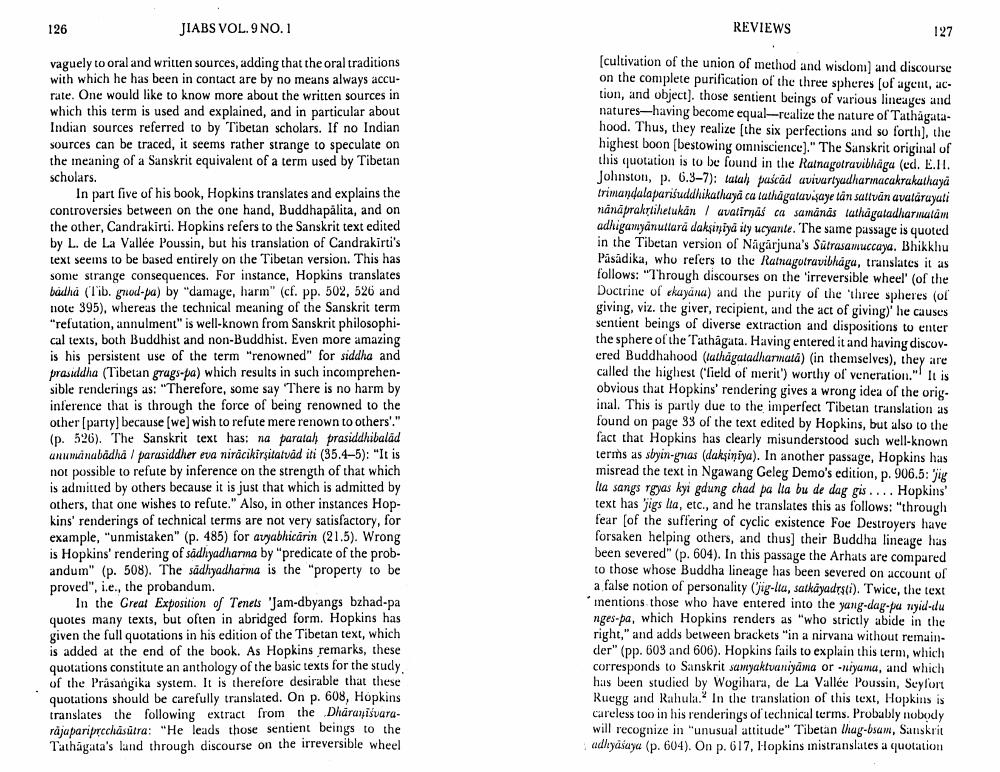________________
126
JIABS VOL. 9 NO.1
REVIEWS
127
vaguely to oral and written sources, adding that the oral traditions with which he has been in contact are by no means always accurate. One would like to know more about the written sources in which this term is used and explained, and in particular about Indian sources referred to by Tibetan scholars. If no Indian sources can be traced, it seems rather strange to speculate on the meaning of a Sanskrit equivalent of a term used by Tibetan scholars.
In part five of his book, Hopkins translates and explains the controversies between on the one hand, Buddhapalita, and on the other, Candrakirti. Hopkins refers to the Sanskrit text edited by L. de La Vallée Poussin, but his translation of Candrakirti's text seems to be based entirely on the Tibetan version. This has some strange consequences. For instance, Hopkins translates budha (Tib. grad.pa) by "damage, harm" (cf. Pp. 502, 526 and note 395), whereas the technical meaning of the Sanskrit term "refutation, annulment" is well-known from Sanskrit philosophical texts, both Buddhist and non-Buddhist. Even more amazing is his persistent use of the term "renowned" for siddha and prasiddha (Tibetan grugs-pa) which results in such incomprehensible renderings as: "Therefore, some say There is no harm by inference that is through the force of being renowned to the other (party) because (we) wish to refute mere renown to others'." (p. 526). The Sanskrit text has: na paratah prasiddhibalad unuminabädha / parasiddher eva niracikirşitatvad iti (35.4-5): "It is not possible to refute by inference on the strength of that which is admitted by others because it is just that which is admitted by others, that one wishes to refute." Also, in other instances Hopkins' renderings of technical terms are not very satisfactory, for example, "unmistaken" (p. 485) for avyabhicărin (21.5). Wrong is Hopkins' rendering of sadhyadharma by "predicate of the probandum" (p. 508). The sadhyadharna is the property to be proved", i.e., the probandum.
In the Great Exposition of Tenets 'Jam-dbyangs bzhad-pa quotes many texts, but often in abridged form. Hopkins has given the full quotations in his edition of the Tibetan text, which is added at the end of the book. As Hopkins remarks, these quotations constitute an anthology of the basic texts for the study of the Prasangika system. It is therefore desirable that these quotations should be carefully translated. On p. 608, Hopkins translates the following extract from the Dharuvisvararájupariprochasülra: "He leads those sentient beings to the Tathāgata's land through discourse on the irreversible wheel
(cultivation of the union of method and wisdom) and discourse on the complete purification of the three spheres (of agent, action, and object) those sentient beings of various lineages and natures-having become equal-realize the nature of Tathagatahood. Thus, they realize the six perfections and so forth), the highest boon (bestowing omniscience)." The Sanskrit original of this quotation is to be found in the Rainagotravibhāgu (ed. E.I. Johnston, p. 6.3-7): tatal pascad avivartyudharmacakrakathaya trimandala parisuddhikathaya ca tathāgatavi aye tan saltvan avatáruyali månaprakstihetukan / avalimās ca samands tathāgatadharmatam adhigamyânullará daksiniya ity ucyante. The same passage is quoted in the Tibetan version of Nagarjuna's Sutrasamuccaya. Bhikkhu Pasādika, who refers to the Ratnagotravibhaga, translates it as follows: "Through discourses on the irreversible wheel' (of the Doctrine of ekayana) and the purity of the three spheres of giving, viz. the giver, recipient, and the act of giving)' he causes sentient beings of diverse extraction and dispositions to enter the sphere of the Tathāgata. Having entered it and having discovered Buddhahood (tathagatadharnata) (in themselves), they are called the highest (lield of merit') worthy of veneration. It is obvious that Hopkins' rendering gives a wrong idea of the orig. inal. This is partly due to the imperfect Tibetan translation as found on page 33 of the text edited by Hopkins, but also to the fact that Hopkins has clearly misunderstood such well-known terms as sbyin-ynas (daksiniya). In another passage, Hopkins has misread the text in Ngawang Geleg Demo's edition, p. 906.5: jig lta sangs rgyas kyi gdung chad pa lta bu de dag gis ....Hopkins' text has 'igs lta, etc., and he translates this as follows: "through fear (of the suffering of cyclic existence Foe Destroyers have forsaken helping others, and thus their Buddha lineage has been severed" (p. 604). In this passage the Arhats are compared to those whose Buddha lineage has been severed on account of a false notion of personality Oig-lta, satkayadrsti). Twice, the text * inentions those who have entered into the yung-dag-pu nyid-du nges-pa, which Hopkins renders as "who strictly abide in the right," and adds between brackets "in a nirvana without remainder" (pp. 603 and 606). Hopkins fails to explain this term, which corresponds to Sanskrit samyaktvaniyama or Nyumu, and which has been studied by Wogihara, de La Vallée Poussin, Seyfort Ruegg and Rahula.? In the translation of this text, Hopkins is careless too in his renderings of technical terms. Probably nobody will recognize in "unusual attitude" Tibetan lhag-bsaw, Sanskrit adhycisaya (p. 604). On p. 617. Hopkins inistranslates a quotation




